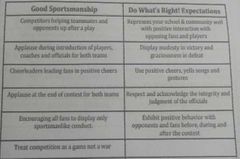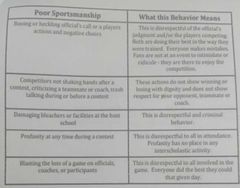![]()
![]()
![]()
Use LEFT and RIGHT arrow keys to navigate between flashcards;
Use UP and DOWN arrow keys to flip the card;
H to show hint;
A reads text to speech;
13 Cards in this Set
- Front
- Back
|
B. Stages of Team Building B.1. _______ Exhibits the characteristic of poor communication within the team. Some members dominate while others will not be able to get their ideas heard. B.2. _____ Exhibits the characteristic of making something definite, distinct and clear B.3. _______ Exhibits the characteristics of spending sufficient time in making observations, generate hypothesis, inferring, explaining and drawing conclusions. |
Chaotic Stage Formal Stage Skillful Stage |
|
|
Elements of a Team |
Common team goal Productive participation of all members Communication Trust Sense of belongingness Participatory leadership Diversity Creativity and risk taking Evaluation Change compatibility |
|
|
Loss of productivity or output Complaints Conflicts between personnel Lack of clear goals Confusion about assignments Lack of innovation Ineffective meetings Lack of initiative Poor communication Lack of trust Employees feel that their work is not recognized Decisions are made that people do not understand or agree with |
Perceived barriers on Team Building |
|
|
Stages of Team Development |
E.1. Forming E.2. Storming E.3. Norming E.4. Performing E.5. Dissolving |
|
|
1. High level of interdependence among members. (Interdependence is interaction within the team, dependent with each other) 2. Leader has good people skills and is committed to team approach. 3. Each member is willing to contribute. 4. A relaxed climate for communication. 5. Members develop a mutual trust. 6. The group and individuals are prepared to take risks. 7. Group is clear about goals and establishes targets. 8. Member roles are defined. 9. Members know how to examine errors without personal attacks. 10. The group has capacity to create new ideas. 11. Each member knows he can influence the agenda. |
Characteristics of a Successful or Good Team: |
|
|
Generally refers to the selection, development, and collective motivation of result-oriented teams. Is pursued via a variety of practices, such as group self-assessment and group-dynamic games, and generally sits within the theory and practice of organizational development.Includes:Knowing Your Core ValuesPositioning for a Common CauseKeeping Team Together In Order to Achieve Your Defined Objectives |
TEAM BUILDING |
|
|
Are designed to help groups develop effective communication and problem-solving skills. |
Team work Activities |
|
|
Approaches to team work: 1. – A goal influences not only individual and group behaviour but also direction, coordination and extent of group efforts– If problems of the group are identified through interviews with group members, they can be handled by group solutions. 2. – Functions more effectively– Encourages sharing of feelings, psychological support for one another, and non-evaluative communication among team members 3. – Is a set of behavior which an individual in a particular organizational position feels obliged to perform and which individuals in other organizational positions expect that person to perform 4. – Aims at productive and cohesive team-workIt involves four steps:A a. Evaluation b. Deliberation and examination c. Elimination and replacementd Trying out new styles of team-work and individual behavior |
1. Goal-setting approach (Beer,1976) 2. Interpersonal approach (Argyris, 1966). 3. Role model (Beer, 1976) 4. Managerial grid model (Blake and Mouton, 1969) |
|
|
Components of team work: (Adair, 1987). 1. _______ - Individuals come to groups with their own needs.They work in groups to accomplish group tasks while simultaneously expecting that group membership will fulfill some of their individual needs. 2. ______ This is the need to achieve something. It is the task on which the group is working. 3. ______ The need to develop and sustain working relationships among members is necessary for the accomplishing of group tasks. This is the maintenance need of the group. |
1. Developing the individual 2. Task achievement 3. Building and maintaining the team |
|
|
1. The team meets and learns about the opportunity and challenges, and then agrees on goals and begins to tackle the tasks. 2. The team addresses issues such as what problems they are really supposed to solve, how they will function independently and together and what leadership model they will accept. 3. Team members adjust their behavior to each other as they develop work habits that make teamwork seem more natural and fluid. 4. These high-performing teams are able to function as a unit as they find ways to get the job done smoothly and effectively without inappropriate conflict or the need for external supervision. 5. Involves completing the task and breaking up the team |
1. Forming 2. Storming 3. Norming 4. Performing 5. Dissolving / Adjourning |
|
|
1. Contribute ideas and solutions 2. Recognize and respect differences in others 3. Value the ideas and contributions of others 4. Listen and share information 5. Ask questions and get clarification 6. Participate fully and keep your commitments 7. Be flexible and respect the partnership created by a team -- strive for the "win-win" 8. Have fun and care about the team and the outcomes. |
Guidelines for effective team membership: |
|
|
“Coming together is a beginning. Keeping together is progress. Working together is success.” – |
Henry Ford |
|

|

|

